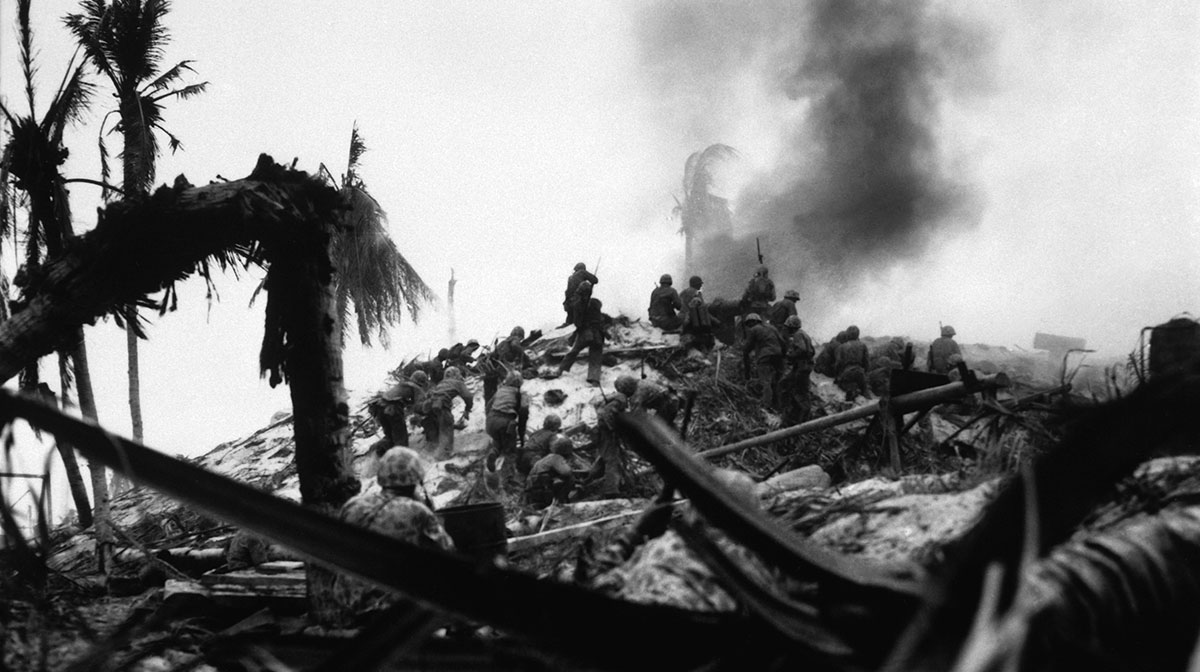A US charity has discovered the bodies of 36 American Marines in Kiribati, including a famous Congressional Medal of Honour recipient, at the scene of some of the fiercest fighting in the Pacific during World War II.
The Marines invaded Japanese-held Tarawa Atoll in November 1943, where more than 1,000 Americans died and the entire Japanese garrison of 4,800 was wiped out.

Photo: Lieutenant Bonnyman and his assault party storming a Japanese stronghold on Tarawa, November 1943. Credit: US National Archives/Obie Newcomb Jr
History Flight director Mark Noah said a combination of archival research of original burial records, radar searches, and interviews with locals had turned up a number of graves since 2007.
He told Pacific Beat this latest discovery is the largest yet, and honours a vow to return the fallen to home soil.
“All of the individuals that died at the battle of Tarawa, or in WWII in general, had the reasonable expectation that if they were to sacrifice their life in the service of their country that they would have the option to be repatriated and buried according to the wishes of their family,” he said.
“That’s on the outside of one of the cemeteries there, an epitaph that said ‘Rest, warriors, rest / Against the day of journeying forth / Tender hands shall lift thee out / To home soil waiting’.”
The remains of the Marines were discovered after a four-month excavation on Betio island, part of Kiribati’s Tarawa Atoll, in a culmination of nine years of research.
Rest, warriors, rest
Against the day of journeying forth
Tender hands shall lift thee out
To home soil waiting.
–Epitaph at Kiribati cemetery for US Marines’ WWII fallen
Mr Noah said 18 of the 36 sets of remains have been formally identified, including what are almost certainly those of Lieutenant Alexander ‘Sandy’ Bonnyman Jr, who posthumously received America’s highest military accolade, the Medal of Honour, for conspicuous gallantry.
“Lieutenant Bonnyman’s teeth were very distinctive, we compared his dental restorations against over 50,000 other individuals and there was only one match,” he said.
Mr Bonnyman’s citation says he led a series of assaults when Marines stormed the island, finally falling when he led a successful attack against a bombproof installation held by 150 Japanese soldiers that was hampering the advance.
The attack on the bunker was filmed by US Marine Corps photographer Norman Hatch whose documentary of the battle, With the Marines at Tarawa, won an Academy Award in 1945 and contains one of the only pieces of footage of a Medal of Honour recipient in the midst of achieving the decoration.
As well as the Medal of Honour, Lieutenant Bonnyman was awarded posthumously the Purple Heart, the Presidential Unit Citation with one blue star, the Asiatic-Pacific Area Campaign Medal with two bronze stars for Guadalcanal and Tarawa, and the World War II Victory Medal.
His family had thought his body would never be found, having been told he was buried at sea. He is the only one of four Medal of Honour recipients on Tarawa not to have returned home.
A statement on History Flight’s website said Mr Bonnyman’s daughters had decided to have his remains interred in a family plot in Knoxville, Tennessee, next to his parents, with a public funeral service planned.
Mr Noah said the remains would be repatriated this month, with the outstanding unidentified remains identified using a combination of dental records and DNA comparison with surviving relatives.
ABC/AFP
Original story at ABC News ab.co/1HVBCGP
